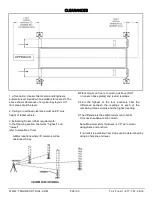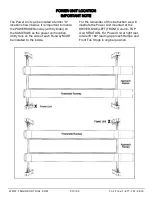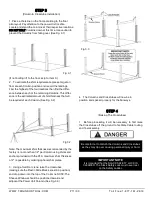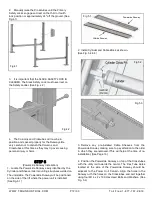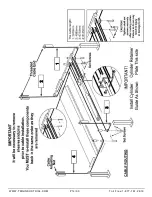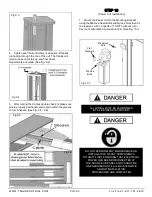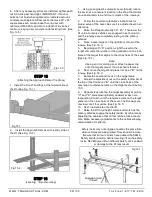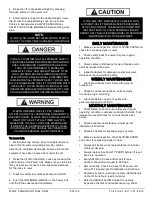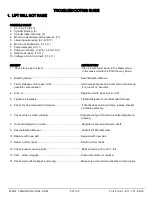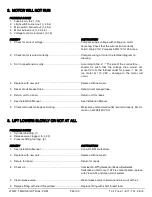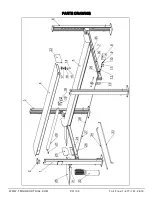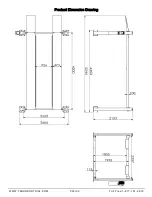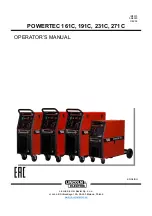
STEP 17
(Bleeding)
1.
Lift must be fully lowered before changing or adding
fluid.
2.
Raise and lower lift six times. The Cylinder is self-
bleeding. After bleeding system, fluid level in Power
Unit reservoir may be down. Add more fluid if
necessary to raise lift to full height. It is only necessary
to add fluid to Raise lift to full height.
3.
To pressure test, run lift to full rise and run motor
for approximately 3-seconds after lift stops. This will
place pressure on the hydraulic system. Stop and check
all fittings and hose connections. Tighten or reseal if
required.
POST-INSTALLATION CHECK-OFF
Columns properly shimmed and stable
Anchor Bolts tightened
Pivot / Sheave Pins properly attached
Electric power supply confirmed
Cables adjusted properly
Safety Locks functioning properly
Check for hydraulic leaks
Oil level
Lubrication of critical components
Check for overhead obstructions
All Screws, Bolts, and Pins securely fastened
Surrounding area clean
Operation, Maintenance and Safety Manuals
on site.
Perform an Operational Test with a typical vehicle
STEP 18
(Lift Operation Safety)
•
DAILY inspect your lift. Never operate if it
malfunctions or if it has broken or damaged parts. Use
only qualified lift service personnel to make repairs
.
•
THOROUGHLY train all employees in use and care of
lift, using manufacturer’s instructions and “Lifting It
Right” and “Safety Tips” supplied with the lift.
•
NEVER allow unauthorized or untrained persons to
position vehicle or operate lift.
•
PROHIBIT unauthorized persons from being in shop
area while lift is in use.
•
DO NOT permit anyone on lift or inside vehicle when it is
either being raised or lowered.
•
ALWAYS keep area around lift free of tools, debris,
grease and oil.
•
NEVER overload lift. Capacity of lift is shown on
nameplate affixed to the lift.
•
DO NOT stand in front of the vehicle while it is being
positioned in lift bay.
•
DO NOT block open or override self-closing lift
controls; they are designed to return to the “Off” or
Neutral position when released.
•
ALWAYS remain clear of lift when raising or lowering
vehicles.
•
ALWAYS use safety stands when removing or installing
heavy components.
•
DO NOT go under raised vehicle if safety locks are not
engaged.
•
NEVER LEAVE LIFT IN ELEVATED CONDITION
unless all Safety Locks are engaged.
•
AVOID excessive rocking of vehicle while on lift.
•
ALWAYS CLEAR AREA if vehicle is in danger offalling.
•
ALWAYS REMOVE tool trays, stands, etc. before
lowering lift.
•
ALWAYS RELEASE safety locks before attempting to
lower lift.
•
DO NOT position yourself between a wall and the lift. If
the vehicle falls in that direction, you may be severely
injured or killed.
To Raise Lift;
1.
Position vehicle tires in the center of each Runway.
2.
Set parking brake and use Wheel Chocks to hold
vehicle in position.
3.
Before raising vehicle, be sure all personnel are clear
of the lift and surrounding area. Pay careful attention to
overhead clearances.
TO AVOID PERSONAL INJURY AND/OR PROPERTY
DAMAGE, PERMIT ONLY TRAINED PERSONNEL TO
OPERATE LIFT. AFTER REVIEWING THESE
INSTRUCTIONS, PRACTICE USING LIFT CONTROLS
BY RUNNING THE LIFT THROUGH A FEW UNLOADED
CYCLES BEFORE LOADING VEHICLE ON LIFT.
NEVER
RAISE JUST ONE END, ONE CORNER,
OR ONE SIDE OF VEHICLE.
WWW.TMGINDUSTRIAL.COM
P22/33
Toll Free:1-877-761-2819


